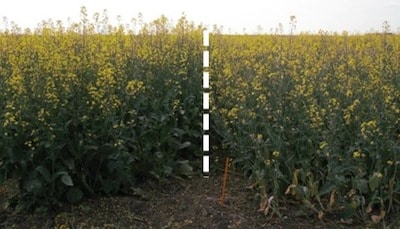
Clubroot resistance is an important part of clubroot management, and growers are advised to start using clubroot-resistant varieties as soon as clubroot is identified in their area. This will help keep clubroot at low levels in fields, and reduce the risk of selecting for resistant clubroot races.
Using resistant varieties only after clubroot is well established in a field could greatly reduce the useful life of that resistance gene. Murray Hartman, oilseed specialist with Alberta Agriculture, says an established clubroot patch could have 1,000,000 times the clubroot spore load than an area with trace clubroot infestation. Within this much higher population of spores, there is a greater chance of selecting for a population that can overcome the clubroot-resistance gene. Hartman adds that patches of established clubroot would also have more genetic diversity due to an age effect (more diversity is known in older established infestations versus recently introduced, younger populations). Thus there is dramatically higher selection pressure on variety resistance once clubroot patches have established in a field.
Hartman draws a parallel between this risk and the risk of weed resistance to herbicides. Hugh Beckie, weed research scientist with AAFC in Saskatoon, predicted in 2010 that kochia would be among the first glyphosate tolerant weeds in western Canada. He was proven right. (Beckie’s study is published here.) One of the key factors in his model was the importance of weed abundance (population size). A large percentage of kochia weeds emerge in the pre-seed window and Beckie’s model predicted that widespread application of pre-seed glyphosate on this large population would increase the chance of selecting for glyphosate-resistant kochia. In many cases of weed resistance, key management advice now is to prevent any escapes from setting seed (such as hand pulling once again practiced in cotton), and this also works by attacking the population size factor. Using clubroot resistance varieties before clubroot becomes a yield-limited threat will keep clubroot spore populations low.
Clubroot as a soil disease, not a canola disease. The intended message in our November article was to remind growers that any practice that moves soil will move clubroot spores. Cultivating cereal stubble will move clubroot spores that had built up in that field the last time canola was grown. Cultivating cereal stubble and then not cleaning the cultivator before moving to the next field will move clubroot spores around the farm. The point is that clubroot management is required in all fields and all years, not just in fields seeded to canola.
Once clubroot has been introduced to a field, spore build up will only occur with host crops (canola) or host weeds. Choosing canola varieties with genetic resistance and using crop rotation are the only management steps to limit spore build up and economic losses in canola. Clubroot does not cause economic damage in any other common Prairie crops.
